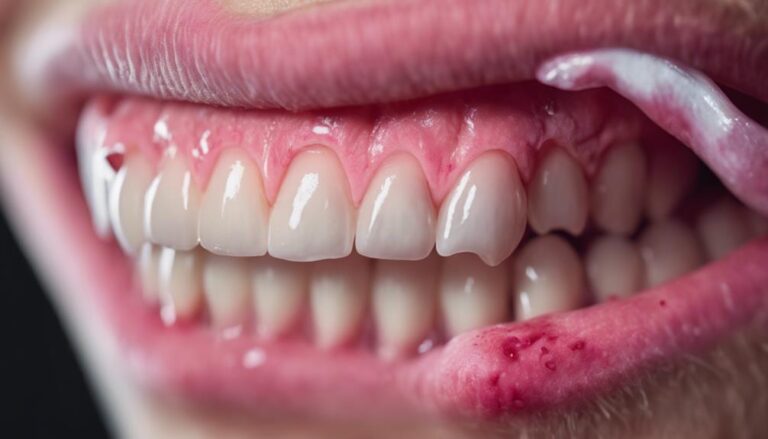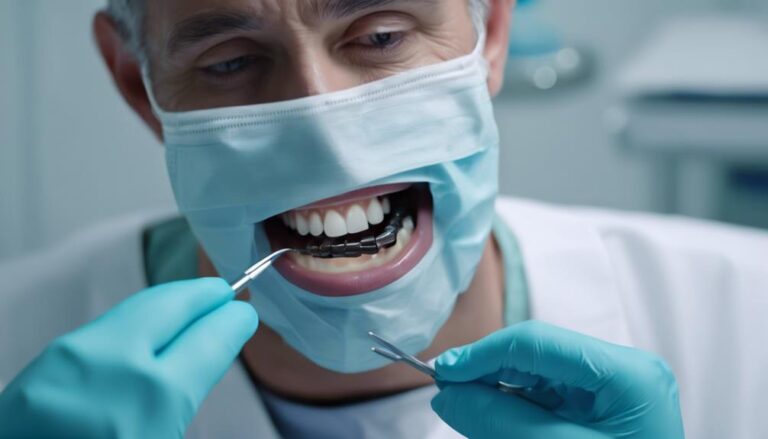Mastering flossing is important in combatting bad breath. Using the right technique is key. Make sure to align the floss against each tooth, gently moving it up and down. Form a ‘C’ shape around each tooth and glide the floss smoothly. Floss daily to remove food particles and bacteria for fresh breath. It’s essential for overall oral hygiene. Maintaining a routine is important. Flossing correctly can prevent gum disease and plaque buildup. Remember, your dentist can provide personalized tips. Improving your flossing skills leads to fresher breath and healthier gums.
Key Takeaways
- Proper floss alignment reaches all areas efficiently.
- Gentle flossing motion prevents gum irritation.
- Forming a ‘C’ shape hugs teeth for thorough cleaning.
- Consistent nightly flossing combats bad breath effectively.
- Regular flossing removes bacteria causing bad breath.
Benefits of Flossing
Flossing daily not only removes food particles and plaque between teeth but also helps prevent gum disease and bad breath. Proper flossing techniques are essential for maintaining good oral hygiene and achieving fresh breath. By incorporating flossing into your daily routine, you can reap numerous benefits that go beyond just cleaning between your teeth.
One of the primary advantages of flossing is its role in preventing halitosis, commonly known as bad breath. Food particles that get stuck between teeth can lead to bacterial growth, which produces unpleasant odors. Regular flossing helps remove these particles, reducing the chances of developing bad breath.
Moreover, flossing contributes to overall gum health by removing plaque buildup along the gumline. Plaque contains harmful bacteria that can irritate the gums, leading to inflammation and potential gum disease. By flossing correctly and consistently, you can lower the risk of gum issues and maintain a healthier mouth. Prioritizing flossing as part of your oral care routine is key to enjoying these flossing benefits and achieving excellent oral health.
Types of Floss
When selecting the most suitable type of floss for your oral care routine, considering the various options available can greatly impact your flossing effectiveness. There are different types of flossing materials to choose from, each offering unique benefits.
Traditional nylon floss is a common choice, available in waxed and unwaxed forms. It’s versatile and can easily slide between teeth. For those with tighter gaps, monofilament floss, which is thinner and slides more easily, may be preferred.
Woven floss is a thicker option that can be gentler on gums. Dental tape, broader and flatter than traditional floss, is suitable for individuals with more space between their teeth.
Understanding the differences between these flossing materials can help you select the most appropriate one for your needs. It’s crucial to also consider your flossing techniques to ensure excellent oral hygiene. Experimenting with various types can help you find the one that works best for you and encourages consistent flossing habits.
Proper Floss Length
To guarantee effective removal of plaque and debris from all surfaces of your teeth, how can you determine the appropriate length of floss needed for each flossing session? When it comes to flossing length, the ideal measurement varies depending on personal preference and the spacing of your teeth. A general rule of thumb is to use about 18 to 20 inches of floss. This length allows you to have enough clean floss to use a fresh section between each tooth without reinserting plaque back into your mouth.
For an ideal flossing technique, it’s important to make sure you have enough length to work with. Holding the floss with the proper grip, wrap the ends around your middle fingers, leaving about 1-2 inches of floss to work between your teeth. Having the right flossing length not only helps in effectively removing plaque but also prevents the risk of reusing contaminated sections, promoting better oral hygiene.
Correct Flossing Technique
Maintaining proper alignment of the floss along the tooth surface is essential for effective plaque removal during flossing. To achieve this, it’s vital to establish a proper grip on the floss. Begin by winding the floss around your middle fingers, leaving a few inches of floss to work with. Use your index fingers and thumbs to guide the floss in between your teeth, ensuring a firm yet gentle hold to prevent snapping or injuring your gums.
Once the floss is in place, focus on the effective motion. Move the floss gently up and down against the side of each tooth, forming a ‘C’ shape to hug the tooth and reach below the gumline. Avoid snapping the floss into the gums, as this can cause discomfort and bleeding. Instead, glide the floss smoothly and carefully to dislodge any food particles or plaque buildup.
Flossing Frequency
For essential oral hygiene, ensuring consistency in the frequency of flossing plays a significant role in maintaining fresh breath and preventing dental issues. Personally, I’ve found that establishing a routine for flossing has been pivotal in achieving top-notch oral health.
Here are some key points to ponder regarding flossing frequency:
- Daily Flossing: Flossing at least once a day is recommended by dental professionals to remove food particles and plaque from between teeth.
- Post-Meal Flossing: Flossing after meals, especially if consuming sticky or stringy foods, can help prevent bacterial growth and bad breath.
- Nighttime Flossing: Flossing before bedtime can eliminate the buildup of debris accumulated throughout the day, promoting a cleaner mouth overnight.
Importance of Interdental Cleaning
Interdental cleaning, an essential aspect of oral hygiene, involves removing plaque and debris from the spaces between teeth to maintain excellent dental health. Neglecting interdental health can lead to plaque buildup, which can result in gum disease, tooth decay, and bad breath. To guarantee excellent oral hygiene, incorporating interdental cleaning into your daily routine is crucial.
There are various oral hygiene techniques that can effectively clean between your teeth, such as flossing, interdental brushes, and water flossers. These tools help reach areas that a toothbrush may miss, promoting overall gum health and preventing oral health issues. Developing a habit of interdental cleaning alongside regular brushing can significantly reduce the risk of dental problems and enhance your oral hygiene.
Flossing Tools
To effectively clean between teeth and promote peak oral health, utilizing appropriate flossing tools is essential. When it comes to flossing innovations and alternatives, there are several options to choose from:
- Water Flossers: These devices use a stream of water to remove plaque and debris from between teeth and along the gumline. They’re gentle on the gums and can be particularly useful for individuals with braces or sensitive gums.
- Floss Picks: Floss picks are small plastic tools that hold a short piece of floss. They offer convenience and ease of use, making them a popular choice for on-the-go flossing.
- Interdental Brushes: These tiny brushes are designed to clean between teeth and around dental work like bridges or implants. They come in various sizes to fit different gaps, providing an effective alternative to traditional floss for those who struggle with manual dexterity or prefer a different sensation.
Flossing Tips for Beginners
When starting a flossing routine, it’s important to establish a consistent technique that effectively removes plaque and debris from between your teeth. As beginners, mastering the art of flossing takes practice and patience. Here are some essential tips to help you kickstart your flossing journey:
| Flossing Tips for Beginners | ||||
|---|---|---|---|---|
| 1. Choose the Right Floss: | Select a waxed or unwaxed floss based on your preference. Thicker floss is ideal for beginners. | |||
| 2. Proper Technique: | Hold the floss tightly between your fingers and gently glide it between each tooth in a C shape. Avoid snapping the floss. | |||
| 3. Consistency is Key: | Floss at least once a day, ideally before bedtime, to maintain excellent oral hygiene. | |||
| 4. Be Gentle: | Avoid aggressive flossing that can harm your gums. Gentle yet thorough flossing is the goal. | |||
| 5. Ask for Guidance: | If unsure, consult your dentist for personalized tips and demonstrations. |
Flossing and Bad Breath
Flossing regularly plays an important role in combating bad breath by removing food particles and bacteria from hard-to-reach areas between your teeth. Proper flossing techniques are essential for bad breath prevention, as they target areas where a toothbrush can’t reach effectively.
Developing good flossing habits is key to maintaining excellent oral hygiene and preventing unpleasant odors in the mouth. Here are three key points to keep in mind:
- Consistency: Make flossing a part of your daily routine to guarantee thorough cleaning and reduce the chances of food particles lingering between teeth.
- Technique: Use a gentle back-and-forth motion, curving the floss around each tooth in a ‘C’ shape to reach below the gumline and remove plaque effectively.
- Tools: Choose the right type of floss for your teeth, whether waxed or unwaxed, tape, or a floss pick, to make the process more comfortable and efficient.
Flossing and Gum Disease
Gum disease, a common oral health concern, can be effectively prevented through proper flossing techniques and regular dental care. Maintaining good gum health is important in preventing gum disease, which can lead to serious complications if left untreated. Flossing plays an important role in oral hygiene by removing plaque and food particles that brushing alone may miss, thereby reducing the risk of gum disease.
Incorporating flossing into your daily oral care routine helps in preventing gum inflammation, bleeding, and ultimately gum disease. By gently sliding the floss between your teeth and along the gumline, you can effectively remove plaque buildup and prevent bacteria from causing gum issues. Consistent flossing not only promotes gum health but also contributes to overall oral hygiene.
Understanding the benefits of proper flossing techniques is crucial for maintaining healthy gums and preventing gum disease. Regular flossing, along with professional dental cleanings, forms a solid foundation for excellent oral health. Prioritizing flossing as part of your daily routine can greatly reduce the risk of gum disease and promote a healthy smile.
Flossing and Plaque Removal
A key component of maintaining excellent oral health is effectively removing plaque through proper flossing techniques. Plaque prevention is important for gum health, as the accumulation of plaque can lead to gum disease if not properly managed.
When flossing to remove plaque, it’s vital to follow these three key steps:
- Proper Technique: Guarantee the floss is gently guided between each tooth, forming a ‘C’ shape to hug the tooth and reach below the gumline where plaque can accumulate.
- Consistent Routine: Floss at least once a day to prevent plaque buildup and protect your gums from inflammation and disease.
- Comprehensive Coverage: Take the time to floss between every tooth, including those hard-to-reach areas at the back of your mouth, to ensure thorough bacteria removal.
Flossing and Halitosis
To combat bad breath effectively, incorporating proper flossing techniques is essential in managing halitosis and promoting oral hygiene. Halitosis, commonly known as bad breath, can be caused by the buildup of food particles and bacteria between teeth and along the gumline. Flossing plays an important role in removing these particles, preventing the formation of plaque, which can lead to foul odors. By flossing at least once a day, you can greatly reduce the chances of developing halitosis and improve breath freshness.
Maintaining good oral hygiene through flossing helps in preventing the accumulation of bacteria that contribute to bad breath. Flossing not only removes debris that brushing alone can’t reach but also stimulates the gums, promoting overall oral health. By incorporating flossing into your daily routine, you can effectively combat halitosis and enhance breath freshness. Remember, consistency in flossing is key to achieving excellent oral hygiene and keeping bad breath at bay.
Flossing for Fresh Breath
To guarantee lasting breath freshness, mastering the proper flossing technique is essential for excellent oral hygiene and combating bad breath. Incorporating fresh breath secrets and flossing hacks into your daily routine can elevate your oral care game to the next level. Here are some tips to help you achieve that minty-fresh breath:
- Use the Right Amount of Floss: Make sure you have enough floss to clean between each tooth without reusing the same section, promoting ideal plaque removal.
- Floss in a C-shape: Gently curve the floss around each tooth in a C-shape to reach below the gumline and remove hidden food particles.
- Finish with Mouthwash: After flossing, rinse with an antibacterial mouthwash to kill any remaining bacteria and leave your mouth feeling clean and refreshed.
Flossing Mistakes to Avoid
Common flossing mistakes can hinder your oral hygiene efforts and lead to potential dental issues if not corrected promptly. It’s important to be aware of these errors to maintain peak oral health.
One common mistake is using too little or too much floss. Inadequate floss may not effectively remove plaque and food particles, while excessive floss can fray and cause difficulties in cleaning.
Another error to avoid is snapping the floss between your teeth, which can harm your gums. Instead, gently glide the floss up and down along the sides of each tooth.
Additionally, rushing through the flossing process can result in missed spots and incomplete cleaning. Take your time to ensure thorough removal of debris and plaque.
Flossing Routine for Optimal Oral Health
For ideal oral health, establishing a consistent and thorough flossing routine is essential in maintaining clean teeth and healthy gums.
When it comes to crafting a flossing routine for best oral health, here are some key practices to keep in mind:
- Consistency: Make flossing a daily habit to remove plaque and food particles that brushing alone can’t reach, preventing gum disease and cavities.
- Technique: Utilize proper flossing techniques such as gentle back-and-forth motions and forming a ‘C’ shape around each tooth to guarantee effective plaque removal without damaging gums.
- Comprehensive Coverage: Make sure you floss between every tooth, reaching the gum line and moving slightly below it to eliminate bacteria and debris that can lead to bad breath and oral health issues.
Frequently Asked Questions
Can Flossing Cause Any Damage to the Gums or Teeth?
Flossing done improperly can damage gums, increasing abrasion risk. However, with proper technique and gentle motions, flossing enhances gum health without harm. Remember to follow prevention tips like using a clean section of floss for each tooth.
Is There a Specific Time of Day That Is Best for Flossing?
In my experience, when it comes to flossing, consistency is key. Both morning and night are beneficial times to floss. Morning flossing can kickstart the day with a fresh mouth, while nighttime flossing helps remove debris before bed.
Can Flossing Help With Tooth Sensitivity?
Flossing techniques are essential for sensitivity management. Proper flossing removes plaque, reducing the risk of gum disease that can lead to tooth sensitivity. Regular flossing is key to maintaining oral health and preventing discomfort.
Are There Any Alternatives to Traditional Floss for Interdental Cleaning?
In the quest for best oral health, exploring alternatives to traditional floss like water flossers and interdental brushes can enhance cleaning between teeth. Varying flossing frequency with these tools can boost overall oral hygiene routines, promoting healthier gums and teeth.
How Long Should I Wait to Brush My Teeth After Flossing?
After flossing, ideal timing for brushing is to wait about 30 minutes. This delay allows fluoride from toothpaste to work effectively. Flossing benefits oral health by removing plaque and debris between teeth, complementing the cleaning action of brushing.
Conclusion
Mastering the art of flossing is like discovering the secret to fresh breath and excellent oral health.
By selecting the right type of floss, using proper technique, and being consistent with your flossing routine, you can combat bad breath and prevent dental problems.
So next time you reach for that floss, remember the benefits it brings to your smile and overall well-being.
Keep flossing for a healthier mouth and a confident smile!






